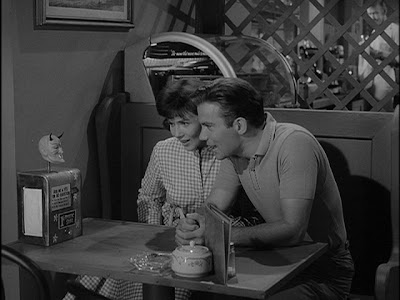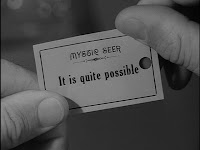Season Two, Episode 44
Original Air Date: December 2, 1960
Cast:
Jana: Inger Stevens
Dr. Loren: John Hoyt
Mrs. Loren: Irene Tedrow
Nelda: Mary Gregory
Robert: Tom Palmer
Gretchen: Doris Karnes
Suzanne: Valley Keane
Jensen: Jason Johnson
Crew:
Writer: Rod Serling (original teleplay)
Director: Jack Smight
Producer: Buck Houghton
Associate Producer: Del Reisman
Art Direction: Craig Smith
Set Decoration: Arthur Jeph Parker
Technical Director: Jim Brady
Assoc. Director: James Clark
Casting: Ethel Winant
Associate Producer: Del Reisman
Art Direction: Craig Smith
Set Decoration: Arthur Jeph Parker
Technical Director: Jim Brady
Assoc. Director: James Clark
Casting: Ethel Winant
Music: stock
Rod Serling's Opening Narration:
"The residence of Dr. William Loren, which is in reality a menagerie for machines. We're about to discover that sometimes the product of a man's talent and genius can walk amongst us untouched by the normal ravages of time. These are Dr. Loren's robots, built to functional as well as artistic perfection. But in a moment Dr. Loren, wife, and daughter will discover that perfection is relative, that even robots have to be paid for, and very shortly will be shown exactly what is the bill."
Summary:
Dr. Loren, a genius inventor, and his wife live in comfort and complete solitude in a large, secluded manor along with their thirty-something daughter, Jana, and a household of programmed servants in the form of intelligent robots, all designed and imbued with artificial intelligence by Dr. Loren. While Dr. Loren and his wife enjoy the peace that comes with having all their needs tended to by the skilled automatons that comprise the household staff, Jana feels trapped in the house and unnerved by her parents’ reliance upon the robots. Jana longs for the world outside and refuses to be shut off in the large house any longer. She threatens to leave and go out into the world if her father does not destroy all of his robots. After pleading with Jana not to make him destroy his life's work, Dr. Loren reluctantly relents and agrees to destroy the robots if Jana will stay with them. Delighted, Jana begins speaking of her dream to live a normal life, to meet a man and settle down and have children. At the mention of children, the look on her parents’ faces tells Jana all she needs to know about her own existence. There are no pictures of Jana as a little girl in the family album because she is, in fact, one of her father's creations. The Lorens could not have children naturally and so Dr. Loren built a daughter for them. Horrified by the idea that she was manufactured by the man she thought was her natural father, Jana lashes out and tells the Lorens that she cannot be their daughter anymore. Despite their pleading with Jana, the Lorens realize that Jana is forever changed by this revelation. The shocking solution to the problem of keeping Jana at home is that Dr. Loren reprograms her as the maid, Nelda.
Rod Serling's Closing Narration:
"Let this be the postscript: should you be worn out by the rigors of competing in a very competitive world, if you're distraught from having to share you existence with the noises and neuroses of the twentieth century, if you crave serenity but want it full time and with no strings attached, get yourself a workroom in a basement and then drop a note to Dr. and Mrs. William Loren. They're a childless couple who made comfort a life's work, and maybe there are a few do-it-yourself pamphlets still available. . . in the Twilight Zone."
Commentary:
"The Lateness of the Hour" has the dubious distinction of being the first of six videotaped Twilight Zone episodes to see broadcast. Turning to videotape was an attempt on the part of the network (CBS) to implement cost cutting measures on the production of the show. The cost for filming an episode crept up toward $65,000 apiece and the network hit the panic button. Videotape was less expensive than film and required virtually no editing since the editing process could be performed on the spot. The limitations of videotape, however, were many. No exterior locations could be used because of the primitive nature of the videotape process at the time. With all work needing to be done on a soundstage, it greatly limited the type of story Rod Serling and company could tell on the videotaped episodes. "The Lateness of the Hour" is a good example of how Serling, never a fan of the use of videotape on Twilight Zone, compromised with the new process, setting his story in a very enclosed environment and requiring virtually no more movement of the scene than would a stage play. It is no coincidence that producer Buck Houghton sought out directors with experience in the live television format since videotape was used in that arena. Director Jack Smight knew well the limitations of videotape and concentrated instead on developing atmosphere in the episode and achieved this to fine effect. What is sorely missed in the episode is the Emmy Award-winning work of photographer George T. Clemens. No director of photography was needed on the videotaped episodes since a technical director operated the switches from a standard four camera setup at the behest of the episode's director.
Veteran character actors John Hoyt and Irene Tedrow brought a veteran presence to their roles and would both work for The Twilight Zone on more than one occasion. Hoyt turned in a coldly menacing performance as the Martian invader in the classic second season episode "Will the Real Martian Please Stand Up?" , shown the following May after the initial broadcast of "The Lateness of the Hour." Irene Tedrow starred previously in the equally esteemed first season episode "Walking Distance" as the main character's, Martin Sloan's, mother.
In terms of quality, "The Lateness of the Hour" lands right in the middle of one of the most often tread themes of the show, that of the robot and its relation to its human counterpart. The show treated the theme very well ("The Lonely," "In His Image") and poorly ("Uncle Simon," "The Mighty Casey") but the episode with which "The Lateness of the Hour" shares the most thematic ground is Ray Bradbury's single contribution to the show, "I Sing the Body Electric," broadcast during the third season. The two episodes, when taken together, nicely display the light and dark sides of the theme of the automated domestic servant and its effect on the household.
In all, "The Lateness of the Hour" is an episode hampered by a thin script, occasional over-acting, and a videotape method which hindered the entire production on a basic level. That said, the nice atmosphere, quick pacing, presence of veteran character actors, and predictable yet enjoyable twist in the tale mark the episode par for the course as the second season kept rolling on. However, following in line behind episodes the caliber of "The Howling Man," "Eye of the Beholder," and "Nick of Time," "The Lateness of the Hour" simply pales in comparison.
Grade: C
Notes:
--Inger Stevens also appears in the first season episode "The Hitch-Hiker"
--John Hoyt also appears in the second season episode "Will the Real Martian Please Stand Up?"
--Irene Tedrow also appears in the first season episode "Walking Distance"
--Mary Gregory appeared in an episode of Rod Serling's Night Gallery titled "The Different Ones."
--Mary Gregory appeared in an episode of Rod Serling's Night Gallery titled "The Different Ones."
--Director Jack Smight also helmed the first season episode "The Lonely," also about a robot, and two additional videotaped episodes from the second season, "Night of the Meek" and "Twenty Two."
--"The Lateness of the Hour" was produced as a Twilight Zone Radio Drama starring Jane Seymour and James Keach.
--Jordan Prejean
Up Next: We take a trip back to the past with Booth Templeton (Brian Aherne), an aging actor who gets an unnerving second look at the old days for which he longs. That’s next time with “The Trouble with Templeton” on The Twilight Zone Vortex.








